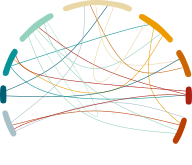
| Retrocopy Name | GPX1P2 |
|
| Species | Homo sapiens | |
| Coordinates (hg38) | chr21:27143134-27143999 UCSC | |
| Coordinates (T2T) | chr21:25501542-25502407 UCSC | |
| Coordinates (hg19) | chr21:28515453-28516318 UCSC | |
| Strand | - | |
| Parental Sequence | NM_000581.4 | |
| Parental seq. overlap | 814 bp | |
| Parental seq. overlap (%) | 89.9% | |
| Genomic Region |
Intergenic |
|
| Retrocopy Summary | GPX1P2, located on chr21:27143134-27143999, is a retrocopy of the parental gene GPX1. Retrocopies of protein-coding genes, also known as processed pseudogenes, are intriguing genomic elements with implications in genome evolution and diseases. While some retrocopies are non-functional, there are examples of retrocopies (retrogenes) acquiring regulatory roles or exhibiting neofunctionalization unrelated to their parental genes. |
| Gene Name | GPX1 |
| Full Name | glutathione peroxidase 1 |
| Also known as | GPXD|GSHPX1 |
| Coordinate | chr3:49357176-49358353 |
| Strand | - |
| Gene summary | The protein encoded by this gene belongs to the glutathione peroxidase family, members of which catalyze the reduction of organic hydroperoxides and hydrogen peroxide (H2O2) by glutathione, and thereby protect cells against oxidative damage. Other studies indicate that H2O2 is also essential for growth-factor mediated signal transduction, mitochondrial function, and maintenance of thiol redox-balance; therefore, by limiting H2O2 accumulation, glutathione peroxidases are also involved in modulating these processes. Several isozymes of this gene family exist in vertebrates, which vary in cellular location and substrate specificity. This isozyme is the most abundant, is ubiquitously expressed and localized in the cytoplasm, and whose preferred substrate is hydrogen peroxide. It is also a selenoprotein, containing the rare amino acid selenocysteine (Sec) at its active site. Sec is encoded by the UGA codon, which normally signals translation termination. The 3' UTRs of selenoprotein mRNAs contain a conserved stem-loop structure, designated the Sec insertion sequence (SECIS) element, that is necessary for the recognition of UGA as a Sec codon, rather than as a stop signal. This gene contains an in-frame GCG trinucleotide repeat in the coding region, and three alleles with 4, 5 or 6 repeats have been found in the human population. The allele with 4 GCG repeats has been significantly associated with breast cancer risk in premenopausal women. Alternatively spliced transcript variants have been found for this gene. Pseudogenes of this locus have been identified on chromosomes X and 21. [provided by RefSeq, Aug 2017] |
| Species | Scientific Name | Retrocopy | |
 |
Chimpanzee | Pan troglodytes | GPX1P1 |
 |
Bonobo | Pan paniscus | GPX1P1 |
 |
Gorilla | Gorilla gorilla | GPX1P1 |
 |
Orangutan | Pongo abelii | GPX1P1 |
 |
Gibbon | Nomascus leucogenys | Without Homology |
 |
Green monkey | Chlorocebus sabaeus | Without Homology |
 |
Crab-eating macaque | Macaca fascicularis | Without Homology |
 |
Rhesus | Macaca mulatta | Without Homology |
 |
Baboon | Papio anubis | Without Homology |
 |
Golden snub-nosed monkey | Rhinopithecus roxellana | Without Homology |
 |
Marmoset | Callithrix jacchus | Without Homology |
 |
Mouse lemur | Microcebus murinus | Without Homology |
 |
Mouse | Mus musculus | Without Homology |
 |
Rat | Rattus norvegicus | Without Homology |
 |
Chinese hamster | Cricetulus griseus | Without Homology |
 |
Rabbit | Oryctolagus cuniculus | Without Homology |
 |
Pig | Sus scrofa | Without Homology |
 |
Cow | Bos taurus | Without Homology |
 |
Sheep | Ovis aries | Without Homology |
 |
Dolphin | Tursiops truncatus | Without Homology |
 |
Horse | Equus caballus | Without Homology |
 |
Dog | Canis familiaris | Without Homology |
 |
Panda | Ailuropoda melanoleuca | Without Homology |
 |
Cat | Felis catus | Without Homology |
 |
Pale spear-nosed bat | Phyllostomus discolor | Without Homology |
 |
Velvety free-tailed bat | Molossus molossus | Without Homology |
 |
Greater mouse-eared bat | Myotis myotis | Without Homology |
 |
Kuhl's pipistrelle | Pipistrellus kuhlii | Without Homology |
 |
Greater horseshoe bat | Rhinolophus ferrumequinum | Without Homology |
 |
Egyptian rousette | Rousettus aegyptiacus | Without Homology |
 |
Sloth | Choloepus didactylus | Without Homology |
 |
Tasmanian Devil | Sarcophilus harrisii | Without Homology |
 |
Opossum | Monodelphis domestica | Without Homology |
 |
Platypus | Ornithorhynchus anatinus | Without Homology |
 |
Chicken | Gallus gallus | Without Homology |
 |
Turkey | Meleagris gallopavo | Without Homology |
 |
Zebra Finch | Taeniopygia guttata | Without Homology |
 |
Budgerigar | Melopsittacus undulatus | Without Homology |
 |
Painted Turtle | Chrysemys picta | Without Homology |
 |
Lizard | Anolis Carolinensis | Without Homology |
 |
Frog | Xenopus tropicalis | Without Homology |
 |
Zebrafish | Danio rerio | Without Homology |
 |
Drosophila | Drosophila melanogaster | Without Homology |
| >GPX1P2 |
| ACAGTGTTTGTTCGGGGCGCTCCCCTAGCTTCTCGGACAGTTGCGCCCTGTGTGCTGCTGGGCTAGCGGCGGCGGCTGCCCAGTCGGTGTAAGCCTTTTCCGCGCGCGCCCGCTGGCCGGCGGGGAGCCTGTGAGCCTGGGCTCCCTGCGGGGCAAGGGACTACTTATCGAGAATGTGGCGTCCCTCGGAGGCACCACGGTCCGGGACTACACCCAGATGAACGAGCCGCAGCGGCGCCTCGGCCCCGGGGCCTGGTGGTGCTTGGCTTCCCGTGCAACCAGTCTGGGCATCAGGAGAACGCCAAGAACGAAGAGATTCTGAATTCCCTCAAGTACGTCCAACCTGGTGGTGGGTTCGAGCCCAGCTTCATGCTCTTGGAGAAGTGCGAGGTGAACGGTGCGGGGGCGCACCCTCTCTCCGCCTTTCTGCGGGACGCCGGCCAGCCCCCAGGGACGACGCCACTGAGCTCATGACCGACCCCAAGCTCATCACCTGGTCTCCGGTGTGTCGCAACGATGTTGCCTGGAACTTCTTTGAGAAGTTCCTGGTGGGCCCTGACGGTGTGCCTGTATGCAGGTATAGCTGCCGCTTCCAGACCATTGACATCGAGCCTGACATCGAAGCCCTGCTGTCTCAAGGGCCCAGATGTGCCTAGGGCGCCCCTCCTACCCCGACTGCTTGGCAGTTGCAGCGCTGCTCTCTGGGGGGTTTTCATCTATGAGGGTGTTTCCTCTAAACCTGCAAGGAGGAACACCTGATCTTGCAGAAAATACCCCCTCGAGATGGGCGCTGGTCCTGTCCATCCCAGTCTCTGCCAAACCAAGGCGAGTTTCCCCACTAATAAAGTGCCGGGTGTCAGCAGAAA |
| >NM_000581.4 |
| AAAAGGAGGCGCCTGCTGGCCTCCCCTTACAGTGCTTGTTCGGGGCGCTCCGCTGGCTTCTTGGACAATTGCGCCATGTGTGCTGCTCGGCTAgcggcggcggcggcggcggcCCAGTCGGTGTATGCCTTCTCGGCGCGCCCGCTGGCCGGCGGGGAGCCTGTGAGCCTGGGCTCCCTGCGGGGCAAGGTACTACTTATCGAGAATGTGGCGTCCCTCTGAGGCACCACGGTCCGGGACTACACCCAGATGAACGAGCTGCAGCGGCGCCTCGGACCCCGGGGCCTGGTGGTGCTCGGCTTCCCGTGCAACCAGTTTGGGCATCAGGAGAACGCCAAGAACGAAGAGATTCTGAATTCCCTCAAGTACGTCCGGCCTGGTGGTGGGTTCGAGCCCAACTTCATGCTCTTCGAGAAGTGCGAGGTGAACGGTGCGGGGGCGCACCCTCTCTTCGCCTTCCTGCGGGAGGCCCTGCCAGCTCCCAGCGACGACGCCACCGCGCTTATGACCGACCCCAAGCTCATCACCTGGTCTCCGGTGTGTCGCAACGATGTTGCCTGGAACTTTGAGAAGTTCCTGGTGGGCCCTGACGGTGTGCCCCTACGCAGGTACAGCCGCCGCTTCCAGACCATTGACATCGAGCCTGACATCGAAGCCCTGCTGTCTCAAGGGCCCAGCTGTGCCTAGGGCGCCCCTCCTACCCCGGCTGCTTGGCAGTTGCAGTGCTGCTGTCTCGGGGGGGTTTTCATCTATGAGGGTGTTTCCTCTAAACCTACGAGGGAGGAACACCTGATCTTACAGAAAATACCACCTCGAGATGGGTGCTGGTCCTGTTGATCCCAGTCTCTGCCAGACCAAGGCGAGTTTCCCCACTAATAAAGTGCCGGGTGTCAGCAGAA |
| PMID - Link | Title |
|---|